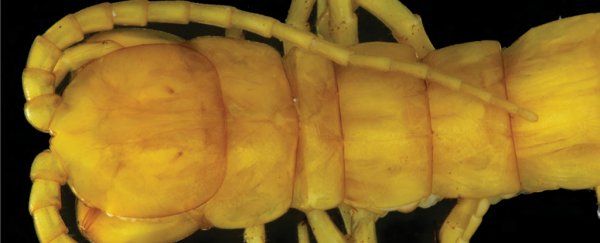The Movile cave in southeast Romania wouldn't be top of your holiday destination list: no light gets down to it, the air is thick with poisonous gases, and it was cut off from the outside world for around 5.5 million years before its accidental discovery in 1986.
Life does exist in the Movile though, and scientists have identified the largest creature they've found there yet. It's a troglobiont (or underground) centipede that has been given the name Cryptops speleorex, and it grows up to 52 mm (2 inches) in length.
The discovery takes the number of endemic species unique to the cave to 35, and it's likely that there are many more to be found in this fascinating underground network – even if explorers can only handle about 5-6 hours in the caverns each time.
 The 'king of the cave' surveys its domain. (Mihai Baciu, GESS LAB, Mangalia)
The 'king of the cave' surveys its domain. (Mihai Baciu, GESS LAB, Mangalia)
"The centipede we described is a venomous predator, by far the largest of the previously described animals from this cave," say the researchers. "Thinking of its top rank in this subterranean system, we decided to name the species Cryptops speleorex, which can be translated to the 'king of the cave'."
Other creatures so far found in the depths of the Movile include water scorpions, leeches, and tiny spiders. They all rely on the nutrients provided by the oxidation of gases, including methane and sulfur by bacteria.
It's the only ecosystem in the world to rely on this type of chemosynthesis, but the cave is unusual in other ways, too. Having been in complete darkness for millions of years, many of the creatures down here are blind and completely colourless.
Some of the species inside the Movile cave can be found outside its boundaries too, but C. speleorex is not one of them. The international team of scientists used DNA analysis to confirm that the centipede was indeed one that had never been seen before.
"Our results confirmed our doubts and revealed that the Movile centipede is morphologically and genetically different, suggesting that it has been evolving from its closest surface-dwelling relative over the course of millions of years into an entirely new taxon that is better adapted to life in the never-ending darkness," say the researchers.
 Exploring the cave. (Mihai Baciu, GESS LAB, Mangalia)
Exploring the cave. (Mihai Baciu, GESS LAB, Mangalia)
With about half the normal level of oxygen in the air and plenty of hydrogen sulfide, methane, ammonia, and carbon dioxide, trips down into the Movile cave have to be brief for researchers. It's also extremely humid in the cave.
Only a small number of researchers ever visit the underground network – it involves a 20-metre (66-foot) rope descent, and then plenty of clambering through tight spaces to reach the central cavern and swimming along submerged channels to see anything beyond.
The journey is undoubtedly worth it from a scientific point of view though. The organisms that call the cave home can teach us a lot about how life survives in the harshest conditions, how it evolves in isolation, and even how it started on Earth to begin with.
For now, C. speleorex is the king of the cave – but it might not be too long before a larger creature is spotted deep in the darkness.
After all, there's always a bigger centipede.
The research has been published in ZooKeys.
